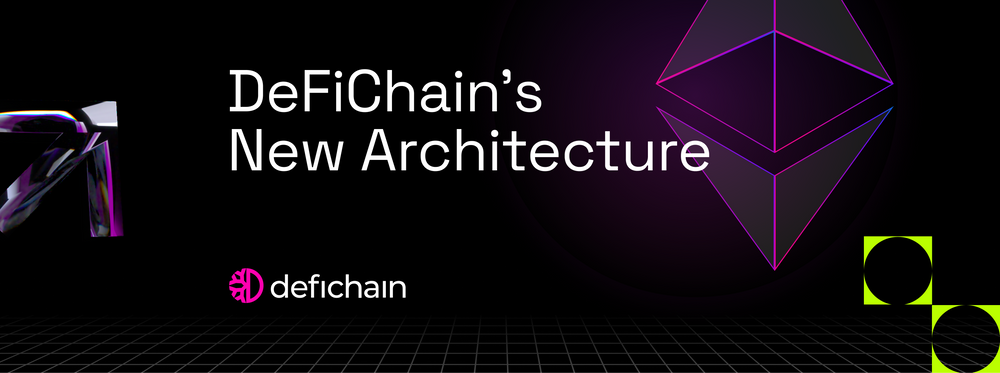DeFiChain’s New Architecture: EVM and UTXO Integration on DeFiChain
In our previous article, we explored the evolutionary transition of DeFiChain – from UTXO to MetaChain. Now, in this follow-up piece, we delve into the architecture of MetaChain and its incorporation of the EVM layer. Ready to uncover DeFiChain's killer features and how they're shaking up the crypto-verse? Let's get this show on the road!
An Architectural Change: EVM Support
The imminent introduction of the Ethereum Virtual Machine (EVM) layer will significantly change DeFiChain's architecture. By incorporating a unique transaction type called xVM, DeFiChain effectively integrates EVM transactions without compromising the UTXO model’s security features.
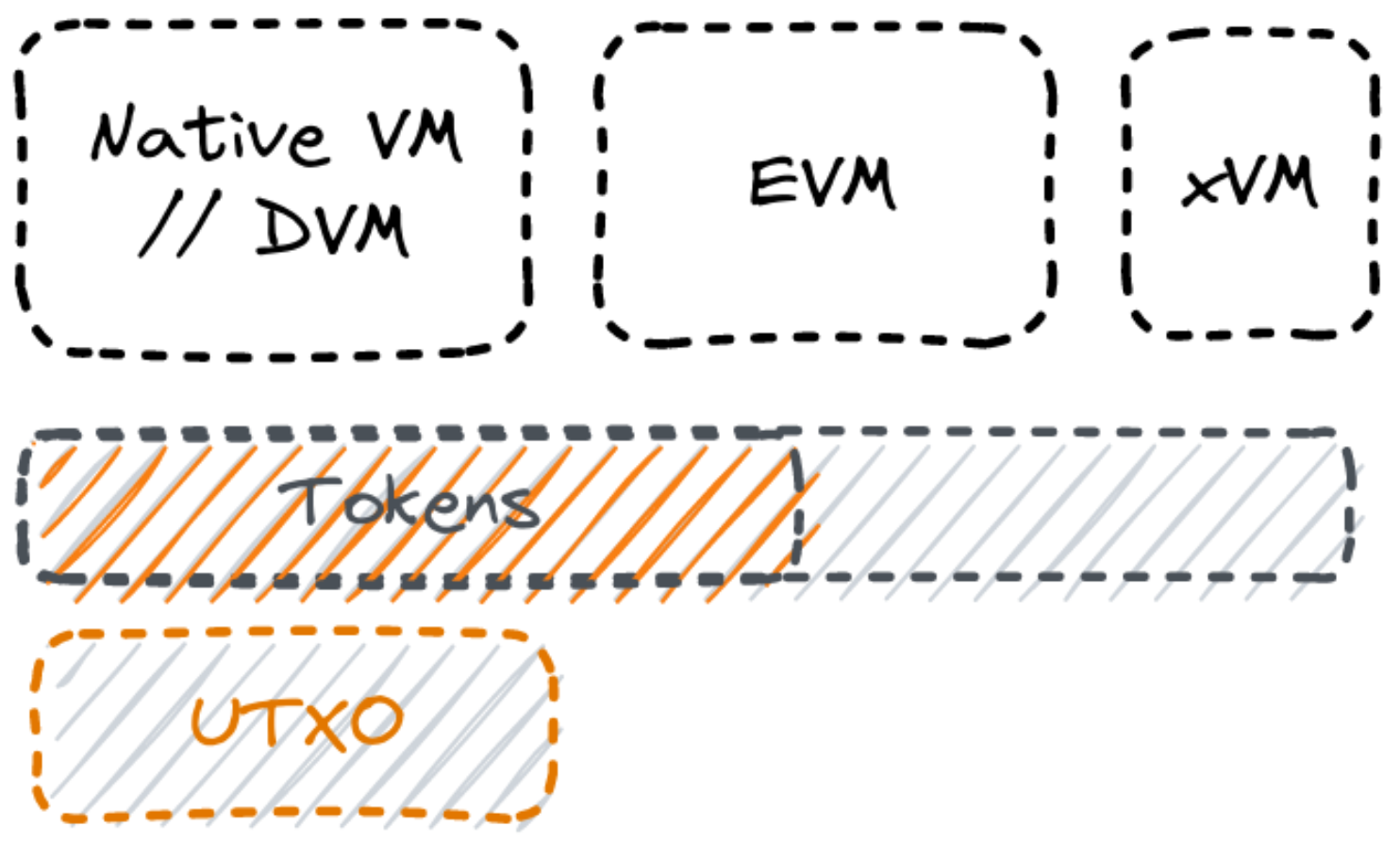
Drawing inspiration from Bitcoin's coinbase transaction concept, the xVM transaction features zero input and output and contains the EVM transaction data. This means that the EVM subsystem can authenticate EVM transactions without any understanding of UTXOs required. This innovation guarantees smooth compatibility with existing Ethereum tools such as MetaMask.
DeFiChain Block Structure: Synthetic Blocks for Ethereum Tooling Compatibility
The DeFiChain block structure comprises a mix of regular UTXO transactions and special xVM transactions. When a DeFiChain node encounters a xVM transaction, the transaction is transferred to the EVM subsystem for validation and execution. By isolating the xVM transaction from UTXO, the security domains are kept intact throughout the integration with the EVM.
With this block structure in place, we can solve one of DeFiChain’s longstanding problems: maintaining compatibility with existing Ethereum tools like MetaMask. The process begins with DeFiChain constructing synthetic blocks that contain complete EVM transactions. These synthetic blocks essentially provide a view of a subset of the DeFiChain block.
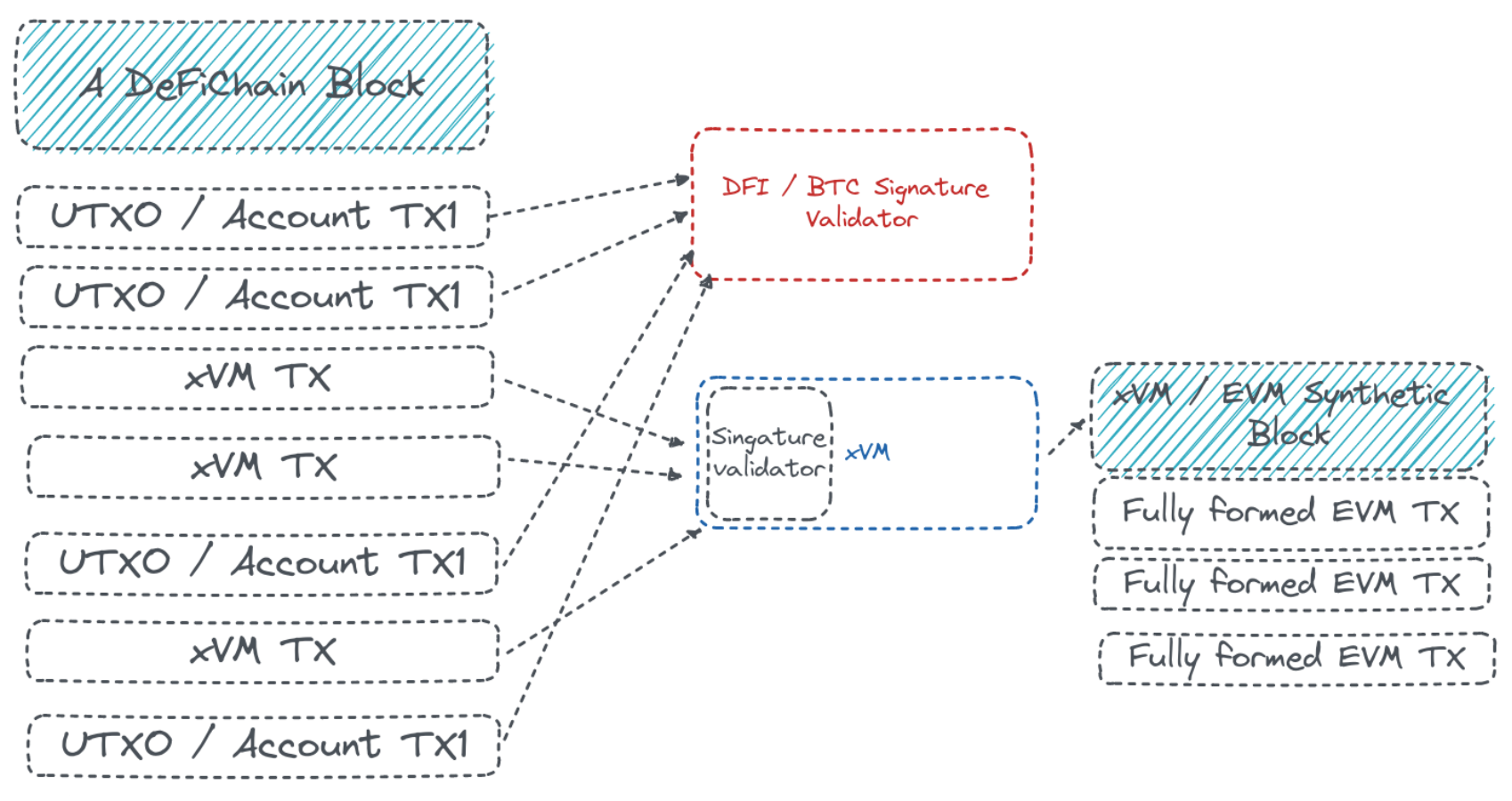
Although these synthetic blocks are not part of DeFiChain, they are the conduits that enable Ethereum RPCs to interact with DeFiChain as if it were an Ethereum blockchain. DeFiChain maximizes its compatibility with existing Ethereum tools and infrastructure with this approach.
Distinct Domains and Seamless Interaction
With the integration of EVM, DeFiChain's ecosystem will comprise three primary domains: UTXO, token systems, and Ethereum Virtual Machine (EVM) accounts. Designed with well-defined boundaries, these domains are rendered unique and distinct from each other. By separating these domains, the UTXO model is protected and enables precise and transparent accounting across the ecosystem.

To facilitate movement between domains on DeFiChain, users must deploy the Transfer Domain Transaction (TX). TX is the exclusive method for transferring assets between different domains, establishing a coherent accounting layer. Using the TX, users can effortlessly and securely navigate their assets within the DeFiChain ecosystem.
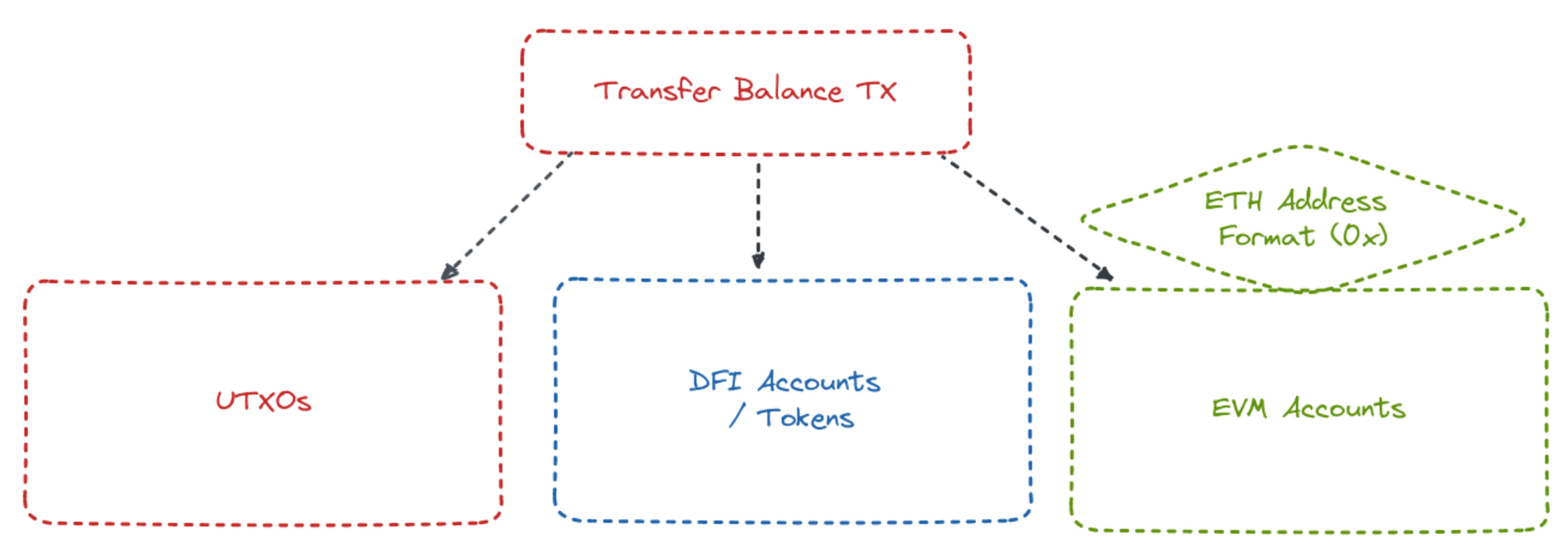
With DeFiChain's nodes now fully supporting Ethereum addresses, transferring funds into the ecosystem has become even more convenient. This compatibility with Ethereum addresses - especially 0x addresses - gives rise to two key benefits:
- The boundaries separating domains are preserved within the DeFiChain node.
- A seamless user experience that enables users to interact with Ethereum-based tools and platforms with ease.
DeFichain Virtual Machine (DVM) - The Heart of the Ecosystem
The DefiChain Virtual Machine (DVM) is the heart of DeFiChain’s ecosystem, serving as the platform's native virtual machine. The DVM plays a crucial role in the DeFiChain ecosystem, empowering users to transfer balances between domains and utilize decentralized finance (DeFi), offering additional functions such as the decentralized exchange (DEX) and governance models.
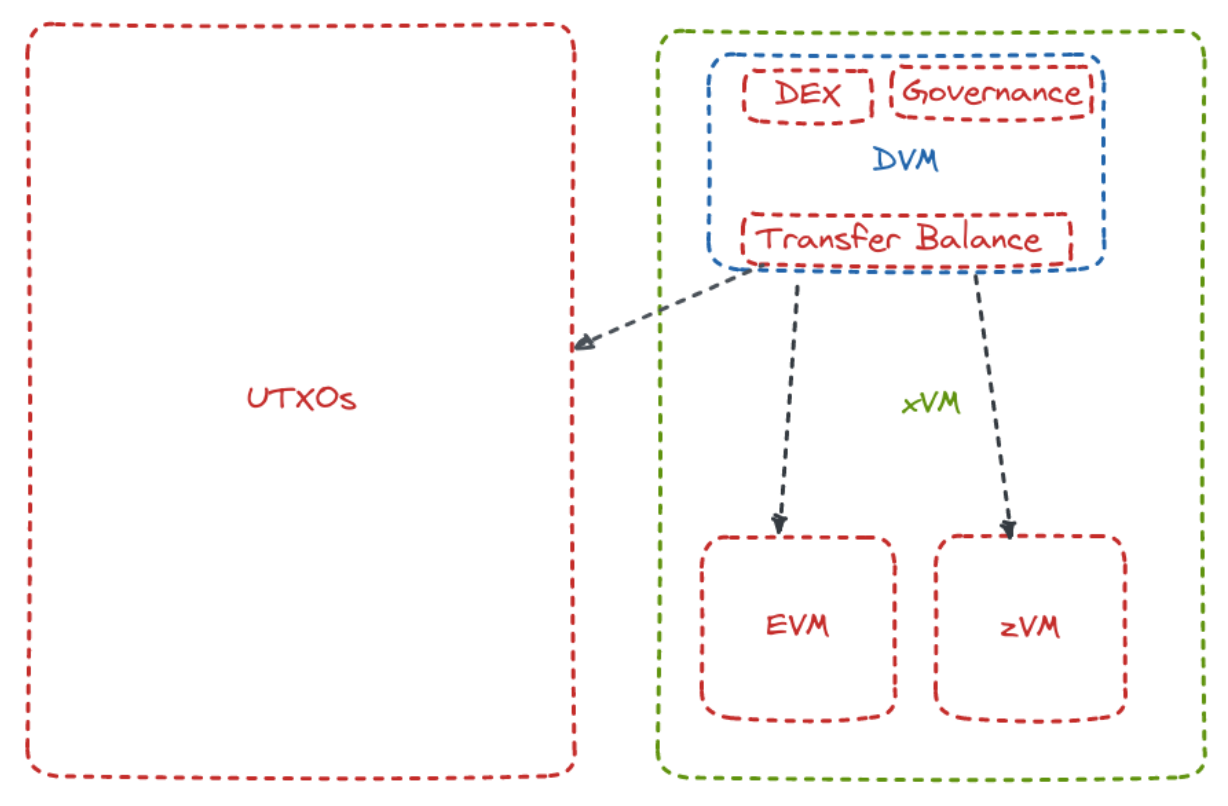
At present, the DVM employs the Auto Auth mechanism for validation. DeFiChain’s new architecture augments the DVM with no-input capabilities, transforming it into a streamlined system that can integrate with other virtual machines like the EVM seamlessly.
By integrating the DVM with other virtual machines, DeFiChain establishes an efficient and adaptable platform for its users, positioning itself as a leader in the DeFi arena.
MetaMask Integration with DeFiChain
MetaMask, the popular Ethereum wallet and browser extension, is now integrated with DeFiChain, making it even more convenient and accessible for users to interact with the blockchain. With this integration, users can access DeFiChain's features through the familiar MetaMask interface.
While there is still room to improve the existing MetaMask integration with DeFiChain, you will find that connecting and using MetaMask with DeFiChain is a straightforward process. Follow these simple steps below:
While the current MetaMask integration with DeFiChain may still need to run smoothly, connecting and using MetaMask with DeFiChain is still straightforward. By following these simple steps, users can easily connect MetaMask to DeFiChain and begin enjoying its features:
- Launch the DeFiChain daemon (defid): Start by running the DeFiChain daemon like you usually would initialize the DeFiChain node.
- Configure your Bitcoin (BTC) tools: Point your BTC tools to the original RPC port for DeFiChain. This will enable you to continue using BTC tools with DeFiChain as before.
- Set up your DeFiChain Virtual Machine (DVM) tools: Direct your DVM tools to the same RPC port as your BTC tools. This ensures that your DVM tools work correctly with DeFiChain.
- Configure your Ethereum Virtual Machine (EVM) tools: Finally, point your EVM tools to the new EVM-specific RPC port. This step enables compatibility between MetaMask and DeFiChain.
A detailed step-by-step guide is also available here.
MetaChain: Dawn of a New Era for DeFiChain
Within the DeFiChain ecosystem, the innovative concept of MetaChain is being developed to expand the scope of Virtual Machines (VMs). Apart from integrating VMs with the DeFiChain platform, MetaChain aims to forge connections with other blockchain networks. This approach will unveil a wealth of new possibilities for DeFiChain and its users.
The development of MetaChain is still in its infancy, with ongoing discussions and brainstorming to define its specific functionality and role within the DeFiChain ecosystem. Fundamentally, MetaChain intends to link various chains, bridge gaps, and enhance interoperability across diverse blockchain networks.

To date, DeFiChain has successfully implemented native DeFi, while the integration of the Ethereum Virtual Machine (EVM) is currently in progress. The upcoming development of the cross-chain protocol will provide the final piece of the puzzle, setting the stage for the MetaChain concept to become a reality.
Though the specifics of MetaChain continue to be fine-tuned, its potential influence on the DeFiChain ecosystem is significant. By connecting multiple chains and broadening the platform's capabilities, MetaChain will generate new opportunities for DeFi applications and drive innovation within the blockchain sector.
In conclusion, DeFiChain's evolution has transitioned into MetaChain development. As the exploration of this concept continues, its potential to transform the DeFiChain ecosystem is evident. The successful integration of MetaChain will represent a crucial milestone in pursuing a more interconnected and adaptable blockchain network.

